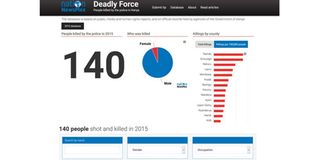Breaking: Autopsy reveals how Cyrus Jirongo died
Premium
Grievances, rivalry drive police to kill colleagues
DESIGN | ALICE OTHIENO
At least 23 police officers were killed by colleagues in the 20 months leading to August 2016, Deadly Force, a database by Nation Newsplex reveals.
That is equivalent to nine per cent of the 262 people killed by police during that period.
The only other group killed at a higher rate are suspected gangsters or robbers.
In the first eight months of 2016 the number of police officers killed by their colleagues had increased by 55 per cent over the whole of last year, according to a Newsplex review of the data.
In 2015, nine police officers were killed by their colleagues. That number is set to double this year if the current trend continues, given that 14 police officers had been killed by their colleagues as of August.
This number does not include police officers who have turned the guns on themselves after killing other officers or who committed suicide without killing their colleagues.
In August the National Police Service formed a team to investigate the killings of police by their colleagues.
The largest number of officers killed in a single incident was seven. In the incident that happened on July 14 this year, Constable Abdihakim Maslam opened fire on his colleagues in Kapenguria with the Officer
Commanding Station (OCS) among the dead. The matter is still under investigation, but the rogue officer, who was also shot dead, is believed to have been radicalised by Al Shabaab. Maslam had served for about two and half years.
In August the National Police Service (NPS) formed a team to investigate the killings of police by their colleagues with a view to establishing the causes and also remedial actions.
The team, headed by the Director of Community Police at Vigilance House, Mr Aggrey Adoli, went round the country investigating cases and interviewed the officers.
The Newsplex analysis revealed some of circumstances related to the police killings included work rivalry, friendly fire, crimes of passion, terrorism and extrajudicial executions.
Junior officers
In most cases, the statistics show, junior officers shot their seniors. Grievances, including unfair deployment, transfers, and disciplinary action among others, have been cited.
According to police headquarters, other shootings have been attributed to the failure of the senior officers to grant leave or time off to their officers.
In one of the cases reported last year, a police constable shot his superior and then turned the gun on himself. Investigations revealed that the junior had been seeking leave but was denied.
Alcohol abuse has also been identified as another cause of police killing each other. In Kericho, where a police driver shot dead the Kericho Directorate of Criminal Investigations (DCI) Charles Mugambi, the officer was found to be intoxicated.
Preliminary investigations revealed that Mugambi had demanded the driver’s keys, to stop him from driving while drunk. The driver refused, leading to a tussle which resulted in Mugambi being shot.
“There is need to mend the situation and to ensure better interaction and exchange of opinion between ground-level police personnel and their superiors,” said a senior police officer.
The principal assistant to the Deputy Inspector-General, Kenya Police, Kingori Mwangi said that given the nature of training, officers were expected to act as per the law, even if they are under pressure. However, there are increased cases where officers overreact out of rage.
Police officers’ conduct with their family, their relationship with their colleagues and seniors among other issues have also been identified as some of the causes. In some cases, it has been revealed that most officers
do not feel free to report their seniors for fear of being reprimanded.
According to Mr Mwangi, the service cannot afford the services of psychiatrists for officers fighting depression, stress, or addiction despite the magnitude of the problem which also calls for periodic review, career progression, medical check-ups, closer communication, and family welfare among others.
Experts say that since within the police environment officers may not admit to experiencing difficulty, it is important for the seniors to watch out for signs like increased lateness, going home early, working excessive hours, absenteeism, withdrawal from social contacts, and frequent mistakes.
Others signs include inability to manage time, frequent accidents and conflict with colleagues.
“Stressed police officers may constitute a threat to themselves, their colleagues, and even members of the public,” he said.
The team investigating why a rising number of police are killing their colleagues was to present their findings to Inspector-General of Police Joseph Boinnet at the end of August.
CLICK BELOW TO VISIT THE DEADLY FORCE DATABASE






